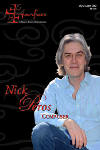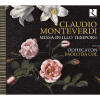Texte paru dans: / Appeared in:

Fanfare Magazine 35:6 (07-08/2012)
Pour
s'abonner / Subscription information
Les abonnés à Fanfare Magazine ont accès aux archives du
magazine sur internet.
Subscribers to Fanfare Magazine have access to the archives of the magazine
on the net.
Ricercar
RIC322

5400439003224(ID206)
Consultez toutes les évaluations recensées pour ce cd
~~~~ Reach all the evaluations located for this CD
Claudio Monteverdi’s Mass for six voices, published with the Vespers in 1610, has been recorded frequently; the three Marian antiphons are premieres. If it seems unlikely that three more works of Monteverdi remain to be recorded, the explanation is simple: Three Marian pieces published some 20 years after his death have been identified as unmistakably Monteverdi’s, and a modern edition appeared last year; only a single copy of the original edition exists. Cantate Domino, published in 1620, has been recorded by Roberto Gini (Fanfare 29:5), Robert King (28:5), James O’Donnell (19:6), Harry Christophers (10:4; CD in 11:1), and many others. The three motets by Giaches de Wert are included because Monteverdi’s career in Mantua overlapped the last few years of Wert’s role asmaestro di cappella there. Monteverdi’s Mass in prima prattica looks back on the sacred music of Wert’s time. The inclusion of the Gombert motet on which the Mass is based is unusual because this is apparently the first recording of the Mass to include the source of the cantus firmus. The recording was made at Santa Barbara basilica in Mantua (Jordi Savall’s Vespro is the only other recording before this that I recall being made there). It may be noted, for better or worse, that the two Salve Reginas are inserted before and after the Credo for contrast.
The choice of a recording of this Mass depends on whether you want the Vespers to go with it. Schneidt, Suzuki (25:2), King, and Gini (34:2) offer the complete 1610 package. Gini includes chant Propers in the Mass, but the tempos are labored, and I prefer Suzuki. Among the numerous separate older versions of the Mass, only Philippe Herreweghe (15:3) and Harry Christophers (10:4; CD in 11:1) are outstanding, both coupled, as it happens, with the Mass published in 1650. (Giuseppe Maletto’s newer but still not recent version did not arrive for review.) This new version is attractive because the fine performance is enhanced by the acoustics of the basilica, which have been used very effectively by the engineers. The notes go into some detail about how they coped with the venue. Considering the alternatives mentioned, this may still be a pleasant choice for new buyers.
Cliquez l'un ou l'autre
bouton pour découvrir bien d'autres critiques de CD
Click either button for many other reviews


